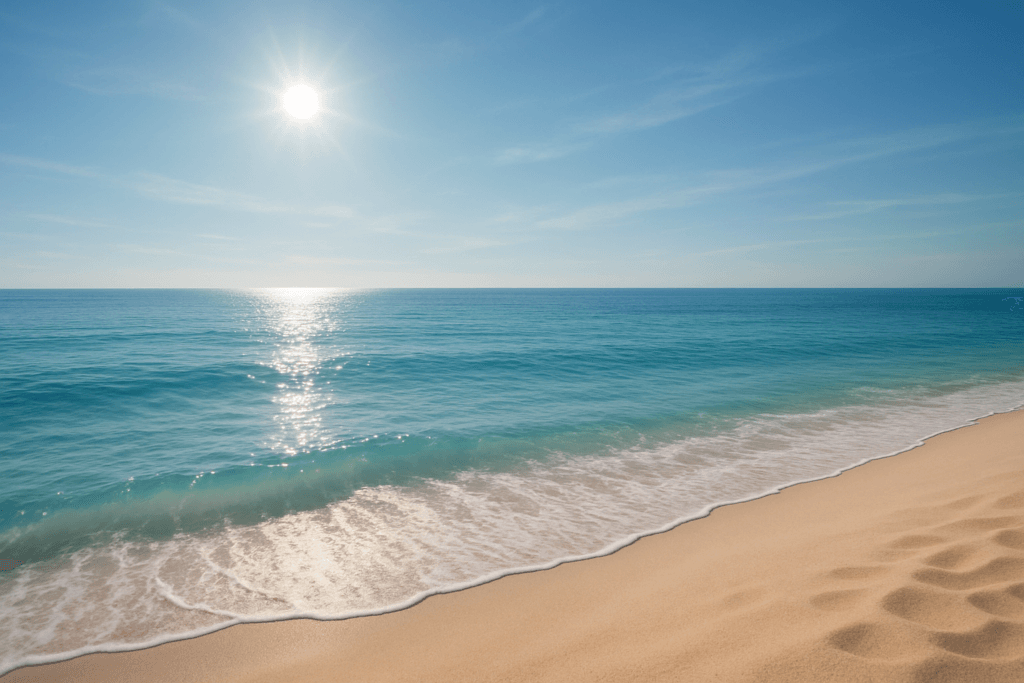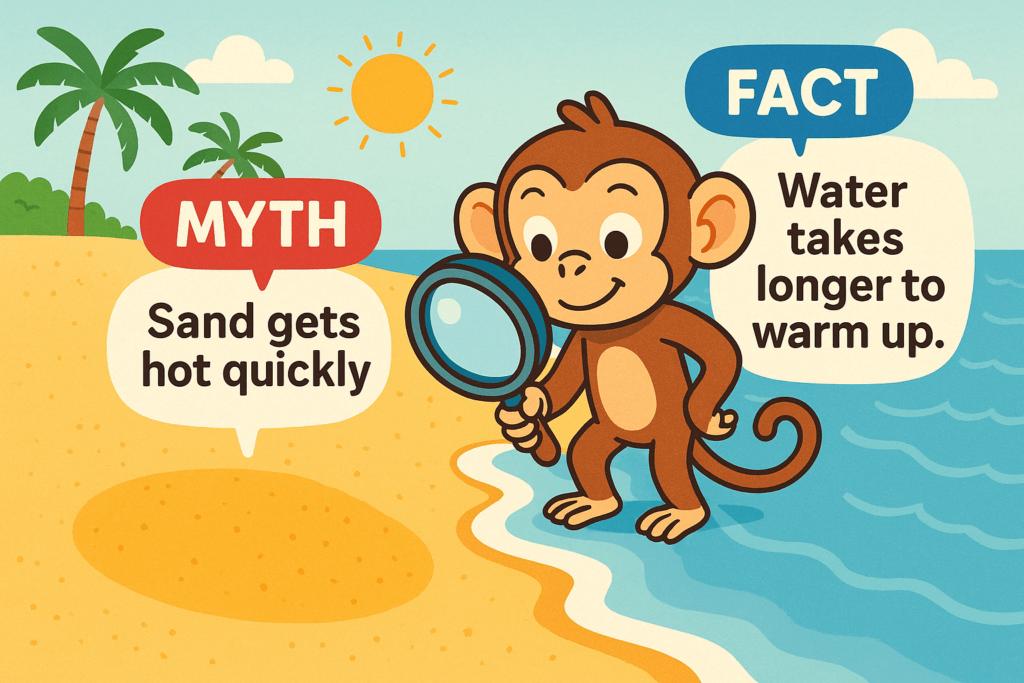Have you ever wondered why, on a sunny day at the beach, the sand is so hot, while the water remains surprisingly cool? It’s a question that many people ask but few fully understand. The answer isn’t as simple as it seems, and the reason behind this temperature difference has to do with the way heat is absorbed, retained, and spread across these two very different substances. Understanding why sand is hot at the beach and water is cold can help you appreciate the fascinating science of how heat works in nature. In this article, we’ll dive deep into this mystery and uncover the reasons behind this everyday phenomenon in an easy-to-understand way, so even a 10-year-old can get the gist of it!
What Makes Sand Heat Up Quickly
Have you ever walked on the beach in the middle of the day without sandals? You can instantly feel the heat of the sand under your feet. The main reason why sand gets so hot at the beach is its low heat capacity. Heat capacity refers to how much heat a substance can absorb before it gets hotter.
When the sun’s rays hit the sand, they are absorbed very quickly. This happens because sand, being a solid, is made up of tiny grains that don’t hold onto heat for long. As soon as the sun shines on the sand, the grains of sand quickly absorb the energy and warm up. However, because the sand has a low heat capacity, it cools down just as fast once the sun goes down.

Think of it like a black t-shirt on a sunny day. A black shirt absorbs more heat than a white shirt, which is why it gets much hotter. Similarly, the sand gets very hot under the sunlight because it absorbs heat quickly, and once the sunlight is gone, it cools down fast too.
How Does Water Stay Cool at the Beach?
On the other hand, when you step into the water at the beach, you often find it to be cooler than the sand, even though the sun has been shining on it all day. The reason water stays cool at the beach lies in its high heat capacity. Water takes longer to absorb heat because it can hold much more energy before its temperature increases. This means that even though the surface water absorbs some of the sun’s heat, the temperature of the water doesn’t rise as quickly as the sand.
Another factor at play here is that water has the ability to spread heat across a larger area. When sunlight hits the water, the heat gets spread throughout the body of water, and the temperature doesn’t rise sharply. Water can also release heat more efficiently than sand, which means it doesn’t store heat for long periods, maintaining a cooler feel throughout the day.

Imagine trying to heat a small bowl of soup versus a large pot of soup. The large pot will take much longer to heat up, and even if it’s hot on the top, the rest of the soup remains cooler. Water behaves similarly, where only the surface layer may feel warmer, but the deeper parts remain cooler.
Understanding Specific Heat Capacity
The key to understanding why sand gets hot quickly and water stays cool lies in a property called specific heat capacity. This term refers to the amount of energy required to raise the temperature of a substance by one degree Celsius.
Water has a very high specific heat capacity compared to sand. This means that for water to increase in temperature, it needs a lot more energy than sand. On a hot day, even though both water and sand are exposed to the same amount of sunlight, the water’s temperature increases much more slowly because it requires more energy to warm up.
The Amazing Polar Day and Polar Night: Why the Sun Doesn’t Set or Rise for Months?
Think about it this way: if you were to put a pot of water and a metal spoon in the same amount of sunlight, the metal spoon would heat up faster because it has a lower heat capacity, while the water would take much longer to warm up. The same concept applies to sand and water.
The Role of Depth in Water Temperature
The depth of the water also plays a significant role in why the water at the beach stays cooler than the sand. Water in oceans or lakes is much deeper than a layer of sand. The sun’s heat can only penetrate the surface layer of the water. Below the surface, the water remains cooler because it isn’t exposed to the direct heat from the sun.
For example, imagine a swimming pool. The shallow end gets warmer as the sun heats the water, but the deeper end remains cooler, even during the hottest parts of the day. The same thing happens in large bodies of water like oceans and seas, where the deeper sections of water stay cooler compared to the surface layers.
On the other hand, sand is only exposed to sunlight on its surface, so there is no deep, cooler layer beneath it. As a result, the temperature of the sand rises quickly and remains hot for a while.
The Effect of Sunlight on Sand and Water
Both sand and water are affected by sunlight, but the way they absorb and retain this energy is different. When sunlight hits the sand, the sand absorbs the energy and gets hot very quickly. This is why walking on the beach with bare feet can feel like you’re stepping on a hot stove!
Water absorbs sunlight too, but because water is transparent, it allows the light to penetrate deeper into its surface, causing the heat to spread throughout. This makes the water take longer to warm up. Even though sunlight continuously shines on the water, the heat is distributed more evenly across a larger volume, preventing the water from getting as hot as the sand.

Interesting Facts About Beach Temperatures
- Sand Can Reach Extreme Temperatures: During the summer, the temperature of the sand can reach over 150°F (65°C), hot enough to burn your feet if you’re not wearing shoes!
- Water Can Be Colder Than the Air: At some beaches, the water is cooler than the air, even though both are being heated by the sun. This happens because water takes longer to absorb heat.
- Ocean Currents Influence Water Temperature: The movement of ocean currents brings cooler or warmer water to different regions, making the temperature of the water vary depending on where you are.
Common Myths About Sand and Water Temperature
- Myth 1: The water at the beach is always cold.
Fact: The water temperature can vary depending on the time of year, geographical location, and local conditions. Sometimes, the water may even be warmer than the sand, especially in tropical areas. - Myth 2: Water always takes longer to cool down than sand.
Fact: While it’s true that water retains heat longer, sand cools down more quickly once the sun sets. So, while water may stay cool during the day, it cools much slower during the night.
Conclusion
In conclusion, the reason why sand gets hot at the beach while the water stays cool has everything to do with the physical properties of sand and water. Sand heats up quickly because it absorbs heat faster, whereas water takes longer to warm up due to its higher specific heat capacity. So, the next time you visit the beach, you’ll have a better understanding of why you can burn your feet on the hot sand but feel cool and refreshed when you dip your toes in the water!
Q1: Why is sand so hot at the beach?
A1: Sand has a low heat capacity, meaning it heats up quickly when exposed to sunlight. It absorbs and retains heat faster than water.
Q2: Why does the water at the beach stay cool?
A2: Water has a high specific heat capacity, meaning it requires more energy to heat up. This prevents the water from warming up as quickly as sand.
Q3: Can the temperature of the water at the beach change quickly?
A3: No, the water takes longer to heat up and cool down due to its high specific heat capacity and its ability to distribute heat over a larger volume.
Q4: Is the water ever warmer than the sand?
A4: In certain circumstances, like in tropical climates or during specific weather conditions, the water may be warmer than the sand.
